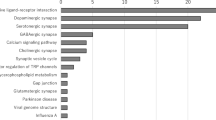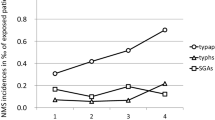Abstract
Background
Neuroleptic malignant syndrome (NMS) is a rare and acute adverse drug reaction associated with antipsychotic therapy. However, few data on the risk and epidemiology of NMS are available.
Objectives
The aim of this study was to ascertain the incidence risk and all-cause mortality of NMS associated with antipsychotic use, and to assess the association of recent antipsychotic exposure and NMS.
Methods
We did a population-based study using data from the Hong Kong Hospital Authority’s Clinical Data Analysis and Reporting System database. Cases had a first diagnosis of NMS between 1 January 2004 and 30 November 2017. A case-crossover analysis was used to compare antipsychotic exposure 30 days before the diagnosis of NMS (index date) and a reference period 91–120 days before the index date. To adjust for potential time trends in antipsychotic exposure, we sampled from cases to match current cases and future cases, and further adjusted for select medications and acute medical conditions.
Results
297,647 patients were prescribed antipsychotics, and the incidence risk of NMS was 0.11%. Of the 336 cases included in the case-crossover analysis, 20 (6%) died within 30 days after the index date; only one case had NMS recorded as the primary cause of death. When compared with the reference period, cases were more frequently prescribed multiple antipsychotics (15.8% vs 26.8%; standardized mean difference [SMD] 0.27) and short-acting injectable antipsychotics (3.6% vs 13.7%; SMD 0.37) during the 30 days prior to the diagnosis of NMS. Odds ratios for antipsychotic exposure in the case-crossover, case-crossover adjusted for time trend, and case-crossover adjusted for time trend and potential confounders analysis were 8.00 (95% confidence interval 3.42–18.69), 5.88 (2.46–14.04), and 4.77 (1.95–11.66).
Conclusions
Our results suggest that recent use of antipsychotics is associated with NMS. Although a case-only design inherently controls for confounding by time-invariant factors, residual confounding by acute medical conditions with similar presentations to NMS cannot be fully excluded.


Similar content being viewed by others
References
Dickey W. The neuroleptic malignant syndrome. Prog Neurobiol. 1991;36(5):425–36.
Stubner S, Rustenbeck E, Grohmann R, Wagner G, Engel R, Neundorfer G, et al. Severe and uncommon involuntary movement disorders due to psychotropic drugs. Pharmacopsychiatry. 2004;37(Suppl 1):S54–64.
Nielsen RE, Wallenstein Jensen SO, Nielsen J. Neuroleptic malignant syndrome-an 11-year longitudinal case-control study. Can J Psychiatry. 2012;57(8):512–8.
Chen Y, Guo JJ, Steinbuch M, Buckley PF, Patel NC. Risk of neuroleptic malignant syndrome in patients with bipolar disorder: a retrospective, population-based case-control study. Int J Psychiatry Med. 2009;39(4):439–50.
Su YP, Chang CK, Hayes RD, Harrison S, Lee W, Broadbent M, et al. Retrospective chart review on exposure to psychotropic medications associated with neuroleptic malignant syndrome. Acta Psychiatr Scand. 2014;130(1):52–60.
Ciranni MA, Kearney TE, Olson KR. Comparing acute toxicity of first- and second-generation antipsychotic drugs: a 10-year, retrospective cohort study. J Clin Psychiatry. 2009;70(1):122–9.
Viejo LF, Morales V, Punal P, Perez JL, Sancho RA. Risk factors in neuroleptic malignant syndrome. A case-control study. Acta Psychiatr Scand. 2003;107(1):45–9.
Belvederi Murri M, Guaglianone A, Bugliani M, Calcagno P, Respino M, Serafini G, et al. Second-generation antipsychotics and neuroleptic malignant syndrome: systematic review and case report analysis. Drugs R D. 2015;15(1):45–62.
Gurrera RJ. A systematic review of sex and age factors in neuroleptic malignant syndrome diagnosis frequency. Acta Psychiatr Scand. 2017;135(5):398–408.
Kawanishi C. Genetic predisposition to neuroleptic malignant syndrome: implications for antipsychotic therapy. Am J Pharmacogenomics. 2003;3(2):89–95.
Maclure M, Fireman B, Nelson JC, Hua W, Shoaibi A, Paredes A, et al. When should case-only designs be used for safety monitoring of medical products? Pharmacoepidemiol Drug Saf. 2012;21(Suppl 1):50–61.
Chan EW, Lau WC, Leung WK, Mok MT, He Y, Tong TS, et al. Prevention of dabigatran-related gastrointestinal bleeding with gastroprotective agents: a population-based study. Gastroenterology. 2015;149(3):586–95 e3.
Man KK, Chan EW, Coghill D, Douglas I, Ip P, Leung LP, et al. Methylphenidate and the risk of trauma. Pediatrics. 2015;135(1):40–8.
Wong AY, Root A, Douglas IJ, Chui CS, Chan EW, Ghebremichael-Weldeselassie Y, et al. Cardiovascular outcomes associated with use of clarithromycin: population based study. BMJ. 2016;352:h6926.
The Government of the Hong Kong Special Administrative Region. LCQ13: resource allocation of Hospital Authority. 2017. https://www.info.gov.hk/gia/general/201712/13/P2017121300666.htm. Accessed 27 Sept 2020.
American Psychiatric Association. Diagnostic and statistical manual of mental disorders (4th ed., Text Revision): American Psychiatric Pub; 2000. Access date Dec 31, 2017.
Lao KSJ, Wong AYS, Wong ICK, Besag FMC, Chang WC, Lee EHM, et al. Mortality risk associated with haloperidol use compared with other antipsychotics: an 11-year population-based propensity-score-matched cohort study. CNS Drugs. 2020;34(2):197–206.
Maclure M. The case-crossover design: a method for studying transient effects on the risk of acute events. Am J Epidemiol. 1991;133(2):144–53.
Wang S, Linkletter C, Maclure M, Dore D, Mor V, Buka S, et al. Future cases as present controls to adjust for exposure trend bias in case-only studies. Epidemiology. 2011;22(4):568–74.
Wang S, Linkletter C, Dore D, Mor V, Buka S, Maclure M. Age, antipsychotics, and the risk of ischemic stroke in the Veterans Health Administration. Stroke. 2012;43(1):28–31.
Wang MT, Tsai CL, Lin CW, Yeh CB, Wang YH, Lin HL. Association between antipsychotic agents and risk of acute respiratory failure in patients with chronic obstructive pulmonary disease. JAMA Psychiatry. 2017;74(3):252–60.
Lao KSJ, Tam AWY, Wong ICK, Besag FMC, Man KKC, Chui CSL, et al. Prescribing trends and indications of antipsychotic medication in Hong Kong from 2004 to 2014: general and vulnerable patient groups. Pharmacoepidemiol Drug Saf. 2017;26(11):1387–94.
Berardi D, Amore M, Keck PE Jr, Troia M, Dell’Atti M. Clinical and pharmacologic risk factors for neuroleptic malignant syndrome: a case-control study. Biol Psychiatry. 1998;44(8):748–54.
Butwicka A, Krystyna S, Retka W, Wolanczyk T. Neuroleptic malignant syndrome in an adolescent with CYP2D6 deficiency. Eur J Pediatr. 2014;173(12):1639–42.
Tamim H, Monfared AA, LeLorier J. Application of lag-time into exposure definitions to control for protopathic bias. Pharmacoepidemiol Drug Saf. 2007;16(3):250–8.
Knott JC, Bennett D, Rawet J, Taylor DM. Epidemiology of unarmed threats in the emergency department. Emerg Med Australas. 2005;17(4):351–8.
Battaglia J. Pharmacological management of acute agitation. Drugs. 2005;65(9):1207–22.
Baker SN. Management of acute agitation in the emergency department. Adv Emerg Nurs J. 2012;34(4):306–18; quiz 19–20.
Bellamy CJ, Kane-Gill SL, Falcione BA, Seybert AL. Neuroleptic malignant syndrome in traumatic brain injury patients treated with haloperidol. J Trauma. 2009;66(3):954–8.
Dixit D, Shrestha P, Adelman M. Neuroleptic malignant syndrome associated with haloperidol use in critical care setting: should haloperidol still be considered the drug of choice for the management of delirium in the critical care setting? BMJ Case Rep. 2013;2013. Access date Dec 31, 2017.
Morita T, Shishido H, Tei Y, Inoue S, Nagayama K. Neuroleptic malignant syndrome after haloperidol and fentanyl infusion in a patient with cancer with severe mineral imbalance. J Palliat Med. 2004;7(6):861–4.
Rock W, Elias M, Lev A, Saliba WR. Haloperidol-induced neuroleptic malignant syndrome complicated by hyperosmolar hyperglycemic state. Am J Emerg Med. 2009;27(8):1018 e1–3.
Acknowledgements
We thank Dr Angel Y.S. Wong for her input in addressing reviewers’ comments, and Dr In Hye Suh and Ms Lisa Lam for their review of the manuscript. This work was presented as an abstract at the International Conference on Pharmacoepidemiology & Therapeutic Risk Management, 24–28 August 2019, Philadelphia, USA. JEB is supported by the Hong Kong Research Grants Council as a recipient of the Hong Kong PhD Fellowship Scheme.
Author information
Authors and Affiliations
Corresponding author
Ethics declarations
Funding
This study was partially funded by the Early Career Scheme, Research Grants Council, Hong Kong (project reference 789813) received by Esther W. Chan. The funders had no role in the design, analysis, interpretation, or publication of this study.
Conflict of interest
All authors declare that no other support has been received from any organization for the submitted work; no other financial relationships with any organizations that might have an interest in the submitted work in the previous 3 years; no other relationships or activities that could appear to have influenced the submitted study. KSJL was formerly employed by the University of Hong Kong where the majority of the work was completed, and is currently employed by Merck Sharp & Dohme China at submission. EWC has received research grants from the Research Grants Council, Hong Kong, Narcotics Division of the Security Bureau of the Government of the Hong Kong SAR, Research Fund Secretariat of the Food and Health Bureau, National Natural Science Fund of China, National Health and Medical Research Council (NHMRC, Australia), Wellcome Trust, Bayer, Bristol-Myers Squibb, Pfizer, Janssen, Amgen, and Takeda, outside the submitted work. ICKW received grants from the Research Grants Council (RGC, Hong Kong), Innovative Medicines Initiative (IMI), Shire, Janssen-Cilag, Eli-Lily, Pfizer, Bayer, European Union FP7 program. IW is a member of the National Institute for Health and Clinical Excellence (NICE) ADHD Guideline Group, the British Association for Psychopharmacology ADHD guideline group, and advisor to Shire. All other authors report no conflicts of interest.
Ethics approval
Research ethics approval was obtained from the Institutional Review Board of The University of Hong Kong/Hospital Authority HKWC (Reference Number: UW 15-619).
Consent to participate
This is a retrospective observational study based on unidentified data. Waiver of patient consent was approved by the ethics committee.
Consent for publication
Not applicable.
Code availability
Not applicable.
Data sharing
No additional data available.
Author Contributions
KSJL, ICKW, and EWC had the original idea for the study and contributed to the development of the idea and study design. KSJL and LL conducted the literature search. KSJL wrote the first draft of the study protocol. KSJL retrieved data and undertook the analysis. JZ independently cross-checked all the analyses and results. KSJL, JZ, JEB, ICKW, and EWC contributed to interpretation of the analyses. KSJL wrote the first draft of the paper. KSJL, JZ, ICKW, JEB, and EWC critically reviewed the results and the manuscript. FMCB, WCC, and DJC reviewed the data, the presentation of the paper, and provided clinical input. KSJL, ICKW, and EWC provided oversight to all aspects of this project. KSJL and EWC are the guarantors. All authors had full access to all the data in the study and take responsibility for the integrity of the data and the accuracy of data analysis.
Electronic supplementary material
Below is the link to the electronic supplementary material.
Rights and permissions
About this article
Cite this article
Lao, K.S.J., Zhao, J., Blais, J.E. et al. Antipsychotics and Risk of Neuroleptic Malignant Syndrome: A Population-Based Cohort and Case-Crossover Study. CNS Drugs 34, 1165–1175 (2020). https://doi.org/10.1007/s40263-020-00767-9
Accepted:
Published:
Issue Date:
DOI: https://doi.org/10.1007/s40263-020-00767-9




